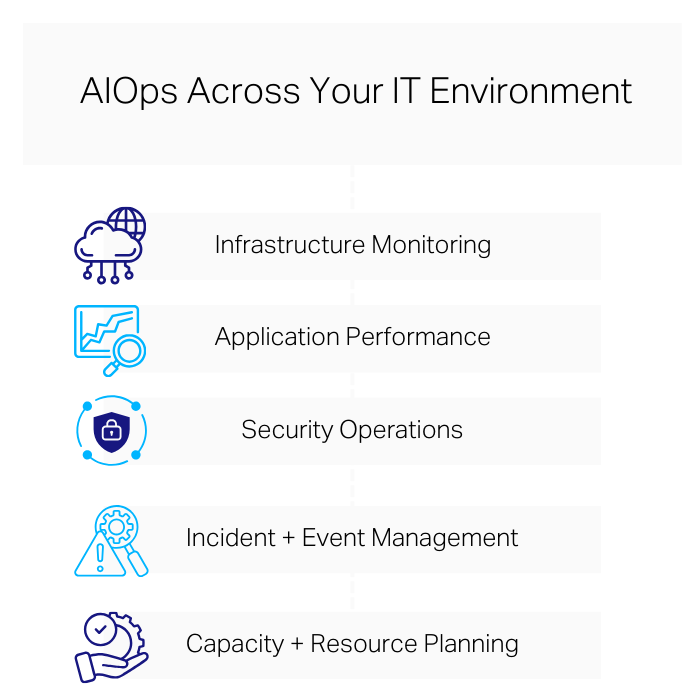What is AIOps? An Intro to AI in IT Operations
IT environments aren’t getting any simpler. Hybrid cloud, SaaS sprawl, dozens of monitoring tools, constant security alerts… and everyone still expects flawless uptime. For many IT leaders, that means teams stuck in reactive mode, firefighting instead of innovating.
AIOps—short for Artificial Intelligence for IT Operations—is changing that. By using AI and machine learning to sift through mountains of data, AIOps spots issues faster, predicts problems before they happen, and can even trigger fixes automatically.
In this post, we’ll break down what AIOps is, why it matters, and how it’s already showing up in the tools you use every day.
What is AIOps?
AIOps is exactly what it sounds like: the use of AI and machine learning to make IT operations smarter, faster, and more efficient.
Gartner, who first coined the term, describes it this way:
“An AIOps platform combines big data and machine learning functionality to support all primary IT operations functions through the scalable ingestion and analysis of the ever-increasing volume, variety and velocity of data generated by IT. The platform enables the concurrent use of multiple data sources, data collection methods, and analytical and presentation technologies.”
In simpler terms, instead of manually combing through logs, chasing alerts, or piecing together root causes from multiple tools, AIOps platforms ingest data from across your environment—servers, networks, cloud services, applications, and security tools—and look for patterns. When something unusual happens, the system can:
Cut through the noise by correlating related alerts and filtering out false positives
Spot anomalies early so issues can be fixed before they impact users
Predict future problems based on historical trends and behaviour
Automate responses to speed up resolution (or prevent incidents entirely)
Think of it as adding a highly skilled, always-on analyst to your IT team (who never gets tired, works at machine speed, and gets smarter over time as it learns your environment).
Why AIOps Matters for Modern IT Environments
Today’s IT teams are under pressure from every direction, with more systems to manage, more data to process, and higher expectations for uptime and performance. Traditional monitoring tools can tell you when something’s wrong, but they often can’t tell you why… or how to fix it before it impacts the business.
AIOps changes that by shifting operations from reactive to proactive. Here’s how it helps:
Reduces alert fatigue: Correlates related events and filters out false positives so your team focuses only on actionable alerts.
Prevents incidents before they happen: Spots anomalies early, helping you address issues before users notice.
Accelerates root cause analysis: Pinpoints the source of problems in minutes instead of hours.
Cuts downtime costs: Faster fixes mean less disruption to revenue and productivity.
Frees up your team for higher-value work: Automation handles repetitive tasks so people can focus on strategy and innovation.
In short, AIOps is a different way of running IT operations that lets teams keep pace with the complexity of modern infrastructure while delivering a better experience to the business.
How AIOps Works in Practice
At its core, AIOps is about turning raw operational data into meaningful action. Here’s the typical flow:
Data Ingestion
Pulls data from multiple sources including monitoring tools, application logs, network devices, cloud services, and security platforms.
Works across on-premises, cloud, and hybrid environments.
Pattern Recognition & Correlation
AI and machine learning models analyze the data in real time.
Correlates related alerts so you see the big picture instead of isolated noise.
Anomaly Detection
Flags unusual behaviour that could indicate a brewing issue, like a sudden spike in CPU usage or unusual network latency.
Root Cause Analysis
Identifies the most likely source of the problem based on historical data and cross-system context.
Automated or Suggested Response
Executes predefined remediation steps (such as rolling back a config change) or recommends actions for the IT team to approve.
Example:
Imagine a spike in network latency. An AIOps platform detects the change, correlates it with a recent configuration update on a specific router, and flags that as the likely cause. With the right automation in place, it can roll back the change automatically, resolving the issue before end users even notice.
Microsoft’s Use of AIOps in Its Products
If your organization already runs on Microsoft, chances are you’re using AIOps without even realizing it. Microsoft has steadily built AI-driven operations into its cloud, monitoring, and security platforms, giving IT teams more proactive capabilities right out of the box.
Azure Monitor + Azure AI
Azure Monitor taps into machine learning to detect anomalies in metrics and logs, correlating them across your resources to highlight the most relevant alerts. When paired with Azure AI and Azure Automation, it can go beyond detection, surfacing proactive recommendations and even triggering automated remediation workflows.
Microsoft Sentinel
Sentinel applies AI to security incident detection, correlation, and prioritization. By reducing false positives and connecting related alerts into a single incident view, it helps security teams focus on what truly matters. Built-in playbooks also allow certain security events to be handled automatically, reducing response time.
Microsoft 365 Defender
Within Microsoft 365 Defender, AI signals are constantly analyzed across email, endpoints, identities, and cloud apps to identify suspicious activity. This enables automated investigations that quickly uncover the scope of a threat and guide the next steps for remediation.
System Center Operations Manager (SCOM) + Azure Monitor
For hybrid environments, SCOM integrates with Azure Monitor to bring AI-driven insights into on-premises monitoring. This combination offers proactive alerting and deep visibility, helping IT teams manage both legacy infrastructure and cloud workloads in one place.
Copilot for Microsoft 365
While best known for boosting productivity in apps like Word and Excel, Copilot’s capabilities are expanding into IT administration. Microsoft is testing Copilot features that help IT teams troubleshoot in natural language, surface relevant system insights, and recommend actions based on operational data.
For IT leaders, the key takeaway is that AIOps isn’t always a separate platform or major new investment. In the Microsoft ecosystem, it’s increasingly embedded into the tools you already use, and those capabilities are only going to grow.
Is AIOps Right for Your Organization?
Not every organization is ready to dive into AIOps on day one. The right timing depends on your current environment, the challenges you’re facing, and how prepared your data and processes are for AI-driven automation.
You might be ready for AIOps if:
Your team is dealing with alert fatigue
You’re managing a hybrid or multi-cloud environment with no central view
Incident resolution times are longer than you’d like
You want to scale IT operations without adding more headcount
Where to Next: Getting Started with AIOps
The best first step isn’t to rush out and buy a new platform, but to assess your current operations. Look at how alerts are handled today, where bottlenecks occur, and which processes could benefit most from automation. In many cases, you may already have AIOps capabilities inside the tools you own—it’s just a matter of configuring and integrating them effectively.
From there, you can:
Start small: Pick one high-impact use case, such as anomaly detection in Azure Monitor or automated incident response in Sentinel.
Integrate with existing workflows: Avoid creating yet another silo by connecting AIOps outputs to your current ITSM or security processes.
Measure and refine: Track metrics like mean time to resolution (MTTR) and alert volume reduction to prove value and guide expansion.
AIOps won’t replace your team, but it will give them better tools to work smarter and stay ahead of issues. When implemented thoughtfully, it can shift your operations from reactive firefighting to proactive, strategic management.
Bringing AIOps Into Your IT Strategy
AIOps is more than a trend. It’s quickly become essential for managing today’s complex IT environments. And if you’re already using Microsoft tools, you may have more AI-driven capabilities available than you realize.
At IX Solutions, we help IT leaders unlock these capabilities, and shift from reactive firefighting to proactive operations.
Want to see where AIOps could deliver the biggest impact for your team? Let’s start with an assessment of your current environment and identify quick wins.


